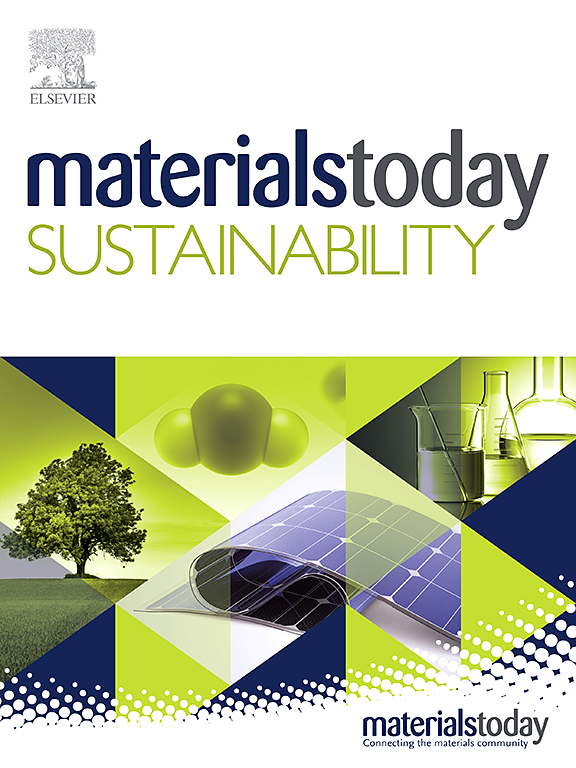High aspect ratio hierarchical carbon nanoplate/functionalized carbon nanotube scaffolds for scalable binder-free ultrafast-charging supercapacitors
IF 7.9
3区 材料科学
Q1 GREEN & SUSTAINABLE SCIENCE & TECHNOLOGY
引用次数: 0
Abstract
Binder-free supercapacitors are effective in achieving rapid charging/discharging capabilities, high power/energy density, and potentially reduced manufacturing costs. In this study, hierarchical carbon nanoplates (HCN) fabricated through the carbonization of high aspect ratio, polycrystalline metal-organic framework nanoplates. These HCN structures are then hybridized with functionalized carbon nanotube (FCNT) scaffolds and applied as electrodes using a scalable shear-coating method, eliminating the need for binders. The synergistic effects of these components result in the capacitance of 206 F/g at 0.8 A/g and 148.8 F/g at 8 A/g with a retention of 72 % in half-cell setups, and a full symmetric cell capacitance of 126 F/g at 4 A/g and 76 F/g at 40 A/g with a retention rate of 61 %. The power and energy densities of the full cell were measured to be 3880 W/kg and 16.2 Wh/Kg, surpassing the upper bound for electrochemical capacitors. The high rate capability and capacitance are attributed to the well-designed architecture of the electrodes and the benefits of the carbon components. Specifically, the high aspect ratio of the HCN with the hierarchical pore structure enhances the active surface area and charge transport properties. Additionally, the increased intermolecular interactions within the FCNT phase create entangled scaffolds, imparting both conductive pathways and mechanical stability. The binder-free nature of the electrodes, complemented by the presence of HCN spacers in the FCNT matrix, expands pores and promotes the transfer of ion species. Importantly, the viscoelastic properties of the HCN/FCNT slurry enable electrode fabrication in large areas by a scalable coating method.

用于可扩展无粘结剂超快充电超级电容器的高纵横比分层碳纳米板/功能化碳纳米管支架
无粘结剂超级电容器在实现快速充电/放电能力、高功率/能量密度和潜在的降低制造成本方面是有效的。本研究通过炭化高纵横比多晶金属-有机骨架纳米片制备了层次碳纳米片。然后将这些HCN结构与功能化碳纳米管(FCNT)支架杂交,并使用可扩展的剪切涂层方法作为电极,从而消除了对粘合剂的需求。这些成分的协同效应导致在0.8 A/g和8 A/g条件下的电容分别为206 F/g和148.8 F/g,在半电池设置下保持率为72%,在4 A/g和40 A/g条件下的完全对称电池电容分别为126 F/g和76 F/g,保持率为61%。测得全电池的功率和能量密度分别为3880 W/kg和16.2 Wh/ kg,超过了电化学电容器的上限。高速率容量和电容归功于精心设计的电极结构和碳成分的优点。具体而言,具有分层孔结构的HCN的高纵横比增强了活性表面积和电荷输运性能。此外,FCNT相中增加的分子间相互作用产生了纠缠的支架,赋予导电途径和机械稳定性。电极的无粘结剂特性,加上FCNT基质中HCN间隔剂的存在,扩大了孔隙,促进了离子的转移。重要的是,HCN/FCNT浆料的粘弹性特性使电极可以通过可扩展的涂层方法大面积制造。
本文章由计算机程序翻译,如有差异,请以英文原文为准。
求助全文
约1分钟内获得全文
求助全文
来源期刊

Materials Today Sustainability
Multiple-
CiteScore
5.80
自引率
6.40%
发文量
174
审稿时长
32 days
期刊介绍:
Materials Today Sustainability is a multi-disciplinary journal covering all aspects of sustainability through materials science.
With a rapidly increasing population with growing demands, materials science has emerged as a critical discipline toward protecting of the environment and ensuring the long term survival of future generations.
 求助内容:
求助内容: 应助结果提醒方式:
应助结果提醒方式:


